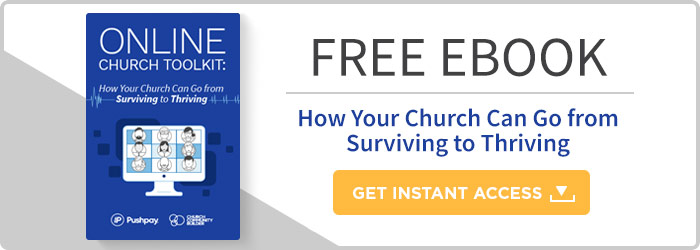10 Ways for Schools to Increase Online Donations
Exactly how prevalent is online giving for schools? Recent reports predict that digital platforms will overwhelm traditional cash-and-check transactions to such an extent that, if the current trajectory doesn’t plateau, the last check will be signed in 2021. Older generations are revising their financial habits, but the younger generations are more likely to rely on exclusively digital platforms. In fact, 20 percent of Millennials have never written a check in their lives. It’s likely some of them don’t even know how.
Across the country, we see more digital-based exchanges and fewer cash-based ones. Five years ago, 36 percent of Americans used cash to make the majority of their purchases. Today, less than a quarter do. The percentage of twenty-somethings who use cash for all or most exchanges is down 18 percent from what it was five years ago.
The decline in cash-based exchanges corresponds directly to increased confidence, familiarity, and perceived safety of digital payment solutions. The implications for nonprofits, charities, churches, and schools is considerable. On one hand, it diminishes the effectiveness of cash-based fundraising efforts. On the other, it provides an opportunity to expand a school’s donor base.
The transition in financial habits we see across the country is dramatic, but the pros far outweigh the cons for America’s schools. To help you make the most of it, here are 10 ways to increase online giving:
1. Make the online donation process simple
As someone with teaching experience, I know people have short attention spans. If you wish to deter a prospective donor from making a donation, resist him by making it complex or lengthy. Many will simply abandon the attempt if it takes them longer than thirty seconds.
Here’s how to make your online donation process painless:
- Link directly to your donation page. On every page of your website should be a “Donate Now” button that directs whoever clicks it to the donation page. They shouldn’t have to hunt for it.
- Require as little information as possible. This isn’t the time or place to do a survey of your donors. Require only the information you need. A name and email are the bare minimum.
- Take different devices into account. Not all of your donors will be making donations on their computers or laptops. In fact, most of them will be using mobile devices—especially phones. Your online form should be compatible with all these devices.
- Make it clear. Your donation process should not require a guide. The format should be simple and intuitive. If you suspect a field or question might be confusing, provide the necessary directions or explanations. Make it so clear a second-grader could do it!
2. Get a mobile app
2014 was a landmark year for the phone: The number of mobile internet users finally exceeded
the number of desktop users. As you might imagine, the disparity has only widened ever since. Any giving solution these days must prioritize the mobile user.
It’s practically a given at this point that the average person spends more time on their mobile device than their desktop. But where are they spending it? The web browser? On the contrary, according to recent reports, 89 percent of time on a mobile device is spent in apps.
Using an app like Pushpay will make your donation process simple, easy, and repeatable. In fact, the app stores the information of any user, so subsequent donations can be made in mere seconds. More importantly, it delivers your fundraising efforts to the transaction platform your donors prefer: their mobile phone.
3. Brand yourself
Branding is critical for charities, nonprofits, and churches in today’s world of online giving. It’s important for your school, too. Branding sets you apart. It conveys a message about your school and what you value. It tells your story. When you brand yourself, you are inviting others to hear that story and become a part of it.
Your donation page should clearly articulate the same messaging and include the design elements of your school. If you look into a mobile app, make sure it is customizable. Branding is necessary to establish rapport with your audience, so don’t sacrifice style striving to be functional.
4. Encourage recurring digital giving
Perhaps the biggest advantage of digital giving is the option for recurring giving. Recurring giving is when donors set up donations to be withdrawn from their bank accounts automatically at predetermined amounts and times: no need to process checks or make phone calls to ask for another donation.
The advantages of recurring giving are considerable:
- Recurring donors give more over time.
- Recurring donors are loyal and easier to retain.
- Recurring donors are incredibly engaged and often give above their recurring gifts.
- Recurring donors make administration so much simpler.
For schools, recurring giving can elevate your bottom line. It also sets you up with a steady, dependable flow of donations.
5. Make requests with a sense of urgency
When it comes to collecting donations, most schools face two problems:
- People are busy. Even donors who intend to give seldom do so when the thought comes to them. They table it and plan to get to it later. (Which they often don’t.)
- We aren’t assertive enough. Striving not to appear demanding, entitled, or even greedy, we make flimsy requests that reward procrastination.
Without a sense of urgency, our requests lose force, and people who would give fail to find the motivation to do so. People respond when they take the request seriously. You can create urgency in several ways:
- Identify expiring opportunities. Let people know about a shrinking window of opportunity. (e.g., “The giving window will only be open for a short time,” etc.)
- Share real-time information. Requests have more gravity if they are brought into proximity with the here and now. (e.g., “Right at this moment, a mother is wondering how she is going to feed her family this evening”; “77 people will be evicted from their home today,” etc.)
- Set a deadline. Sometimes this is enough to compel response. The closer the deadline, the stronger the response. (e.g., “We need all donations to be in by Monday, November 30”; “We have one week to meet our goal,” etc.)
6. Show progress toward digital-giving goals
A progress thermometer indicates progress toward a financial goal, and practically every fundraiser has one. Not only do they chart your progress, but they create enthusiasm as you near your goal.
In the end, a donation is little more than a sign that people are invested in your story. Even those who can’t or haven’t given can still be drawn into the story. Keeping them updated on your progress is like opening up an opportunity for them to make a donation later. Meanwhile, seeing progress toward a goal builds confidence among donors in its reachability. It creates immediate feedback to their donations which says, “Hey, you made an impact!”
Prepare to make regular updates on your progress as you organize your giving solution.
7. Connect online-giving goals to outcomes
The tendency for schools is to measure activities instead of results. Partly, this is because things like enrollments, donations, and website visits are easier to measure. It’s not so easy to measure outcomes, but that’s what really registers with your donor base. It establishes a direct link between their donations and real positive results.
Let’s say your school just enlarged a section of the building, but now you have to buy the chairs to fill it. There are two ways to communicate this need to your donors: first, you can make people commit to purchasing chairs, then update them on the number of chairs purchases; or, second, you could tie the goal of buying 300 new chairs to the actual desired outcome: giving more people the opportunity to learn about your school.
8. Connect digital giving with community
Right now, the mobile phone is an essential part of the daily life of most Americans. Not only does it conduct an extraordinary amount of communication, but it can double as an alarm clock, a research library, a calculator, and so on. In the same way, mobile giving needs to be an integral part of your school community.
Everything you do should in some way cycle back around to the phone. Make it your job to brief the members of your school community on the advantages of giving digitally. Take time to demonstrate how to use those digital tools to give.
Your website, email signatures, flyers, handouts, and all social media accounts should link to your app or digital giving platform. If anyone ever wants to give to you, it should not take them more than a few seconds to find out how.
For school, becoming integrated mobily is easy to accomplish. With a tool like Pushpay’s Total Engagement Solution, you can have a custom and branded app that every member can use every element of community. Additionally, it makes donating a snap. Since they’re engaged with this app regularly, they have an opportunity to give regularly, too.
9. Clearly articulate the benefits of online giving
People may be more comfortable with managing finances across digital platforms, but that doesn’t mean there aren’t any lurking apprehensions. Make the following benefits crystal clear:
- It’s easy. You already use your phone for so much, and you always have it with you. By giving on your phone, you are transferring your financial habits to the same place where all your other habits are.
- It’s fast. If you’re using an app like Pushpay, you can make a donation in seconds.
- It puts your money to use more quickly. The funds are transferred from your account to the school’s immediately—no counting, logging, or errands to the bank required.
- It’s green. Fewer checks means fewer stamps and envelopes.
- It’s secure. Digital giving cuts out the middleman and eliminates other opportunities for your donation to be misplaced or stolen.
- You give when you want to. If you feel the need to give, you can. You do not rely upon our institution to give your gift.
10. Make digital giving fast
Your digital giving solution needs to accommodate your donor’s inclination to give. This means as many obstacles as possible should be lifted. Every additional step in the donation process increases the likelihood that your donor will drop out. Conversely, a speedier process will increase the chances of success.
Pushpay knows the importance of speed. After donors download the app and make their first payment, every subsequent payment involves only three small steps. In total, it takes about 10 seconds to make a donation.
Online giving is changing the game for schools
If people from 60 years ago could see the tech-saturated world in which we live, they’d think they were watching a sci-fi. In our pockets, we carry phones that are also cameras, calculators, messengers, timers, tiny televisions, etc. It has changed the way we do everything, including how we raise funds.
Donations to charities and nonprofits are on the rise, and studies attribute it to the proliferation of the personal mobile device. Strange as it may sound, people are more generous because they own smartphones. If you want your institution to benefit from this record-breaking benevolence, you need to take advantage of modern digital giving platforms. And the sooner, the better.
If you’re ready to really explore how mobile giving can work at your school, download a free copy of the book 7 Types of School Parents. It profiles the most common personas you will come across, and how you can engage each one most effectively using your school app.
Featured Content
You May Also Like


